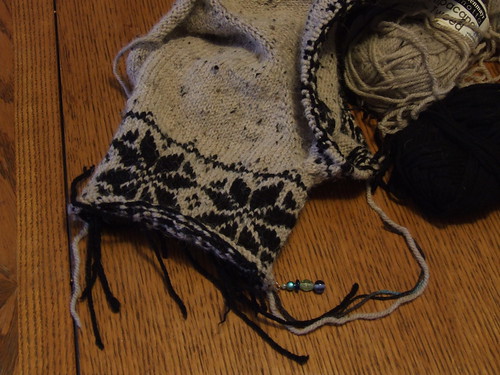
This sweater that I mentioned yesterday, the cardigan that I am working on, is rewarding in many ways, and in other ways it is quite frustrating. I have been planning to make this since the first or second year after I learned to knit. I remember buying the seven balls of alpaca blend yarn on sale and imagining it as a zip-front, mock turtleneck cardigan with a band of scandinavian-style colorwork in black near the bustline. There was no pattern for this cardign, just a distinct picture in my mind. Of course, at the time, I was totally intimidated by the idea of knitting a whole sweater or trying fairisle, not to mention designing a sweater, and I wasn't savvy enough at the time to buy any of the same stuff in black. Later, I bought some black merino in another sale bin at another shop, hoping it would work for the planned cardigan. All of this yarn sat in my yarn basket for years, waiting. Five or six years later, in 2008, I knitted my first sweater. The next year, I took a class and used Barbara Walker's top-down knitting formula, but doing a certain amount of designing myself, especially when it came to the fit in the torso. In January of this year, I finished my first fair-isle pattern. Finally, a couple of weeks ago, I started the cardigan I had been planning.
First, I started with the cardigan formula in Barbara Walker's book, Knitting from the Top. I worked consistently down to the point at the edge of the shoulder, but I may have gotten my measurements confused when I calculated if the increase should stay at the same rate for the sleeves and the body after that. I decided to knit abutting bands in garter stitch for a zipper front, even though I now know that installing zippers in knits is trickier than when sewing garments. I will add some kind of collar when the rest of the cardigan is complete.
I played with several different colorwork designs, paying careful attention to the final height of each, and how many repeats each would produce, so that I would end up with a flattering result. I decided to place the band of pattern just under my armpits, and I carefully adjusted the number of stitches so that it would provide complete repeats. In hindsight, this may have been a mistake, and I fear that the sleeves are too big, as there is excess fabric at the armpit. On the other hand, this is supposed to be something that I will wear as a layer over other things, so I don't want to make it tight. I am also unsure if the fit in this area will change once I add the body, so I have decided to complete the colorwork area on the body before continuing with the sleeves.
Before I started knitting with the black, I had to check if the two yarns would work together, or if I should buy new black yarn. The black seems to be the same size when I use the twist the strands together test, but it is labeled as a different weight of yarn, and of course it has a different fiber content. I decided it would probably be fine, and I went ahead. The tension on the fairisle area is very different from the rest of the sweater. It is much stiffer. I am not sure if this is simply the result of having two layers of yarn, if it is poor tensioning on my part while knitting fairisle, or if a yarn weight or fiber content discrepancy is to blame. I don't know if this is the cause of the poor fitting I am seeing at the armpits. Whatever the case may be, the black was certainly miserable to work with on the sleeves. The main reason for this was that horrible four -letter word that strikes fear into the heart of every knitter: moth. Every few feet, the ball I was working with had been partially chewed through. Maybe it wasn't moths, maybe it was something that had rubbed the yarn in some way, I don't know, but I did have to cut it every few feet and start a new piece to prevent weak spots. In the photo above, you can see many of the ends I will have to weave in dangling from the sleeve pictured. Now, some of you wil say I could spit-splice this yarn, but I have not had much success getting it to work well for me with yarns with a higher number of plies. So weaving in the ends it is.
I do believe that only one ball of the black was afflicted in this way. I started the body with the other ball, and I have yet to encounter a weak spot. If I have to redo the sleeves due to fit issues when I have tried it on with the body complete, and if I have enough yarn left in the good ball, I will certainly knit it with the un-damaged yarn. I'm not giving up. After all, I am finally using my oldest yarn for a project I have wanted for many years, still there are a lot of ends to weave. Whatever the case, the remaining black yarn will be going in the trash bin.
No comments:
Post a Comment